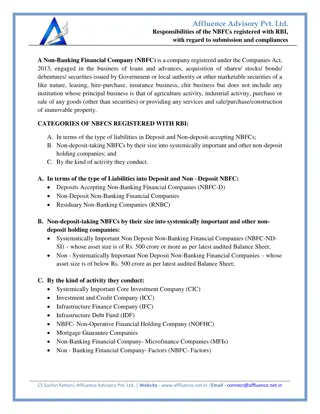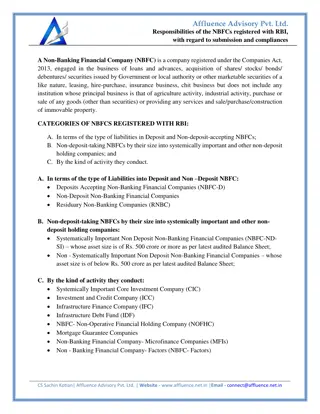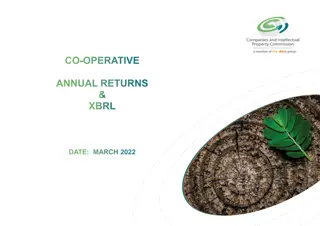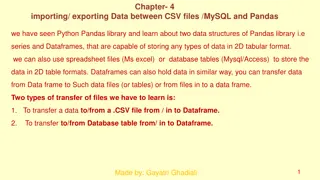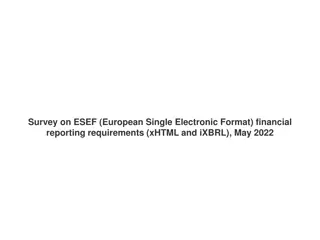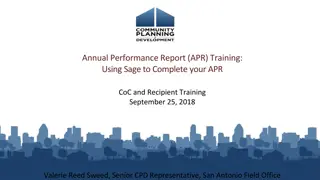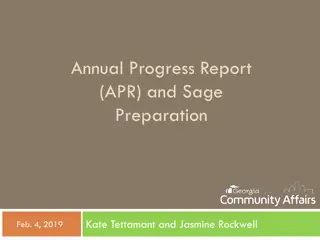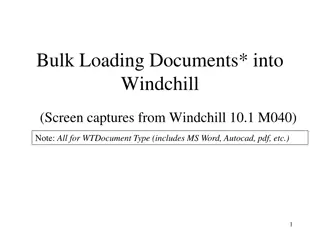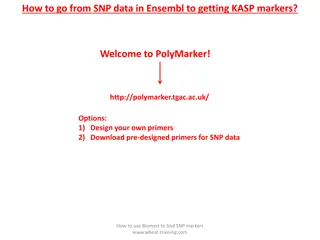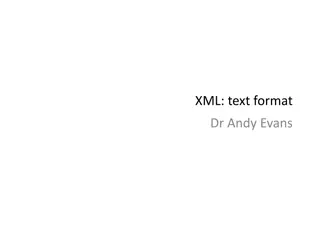xBRL-CSV OVERVIEW
xBRL-CSV offers a standardized and flexible approach for handling XBRL data. It combines the benefits of CSV format with rich XBRL metadata, facilitating bulk data collection and publication. With xBRL-CSV, you can define CSV file layouts using JSON metadata, making it suitable for various types of XBRL reports. Aspects like value, columns, entities, periods, units, and dimensions can be defined to build structured data models efficiently. Explore examples and concepts to understand how xBRL-CSV simplifies data modeling for complex reports.
Uploaded on Feb 15, 2025 | 5 Views
Download Presentation

Please find below an Image/Link to download the presentation.
The content on the website is provided AS IS for your information and personal use only. It may not be sold, licensed, or shared on other websites without obtaining consent from the author.If you encounter any issues during the download, it is possible that the publisher has removed the file from their server.
You are allowed to download the files provided on this website for personal or commercial use, subject to the condition that they are used lawfully. All files are the property of their respective owners.
The content on the website is provided AS IS for your information and personal use only. It may not be sold, licensed, or shared on other websites without obtaining consent from the author.
E N D
Presentation Transcript
xBRL-CSV xBRL-CSV provides a flexible, standardised approach for XBRL data, built upon the Open Information Model (OIM) and the W3C s Tabular Metadata specification 2
Why CSV? Ubiquitous support Very efficient for large data sets, particularly those with large volumes of repeating records xBRL-CSV is aimed at bulk data collection and publication Combines the benefits of the CSV data format with the rich metadata provided by XBRL
CSV: one size does not fit all No single format of CSV document would be suitable for all types of XBRL Report xBRL-CSV makes it possible to define the layout of CSV files (tables) using JSON metadata JSON metadata file groups a set of CSV files, and defines the layout of each table and its mapping to XBRL Metadata file uses & extends the W3C Tabular Metadata standard
xBRL-CSV: BUILDING A FACT Fact = Value + Aspects Aspects can be defined on: Columns (e.g. column of values for Profit concept) Report (e.g. all facts have the same entity) Table (e.g. facts for a particular dimension value) Another cell in the same row Aspects: Concept Period Unit Entity Dimensions Aspects inherit and can be overridden (e.g. a default unit for all facts)
xBRL-CSV: Loan data example Consider a simple report consisting of information about loans issued to a number of companies:
xBRL-CSV: Loan data example Consider a simple report consisting of information about loans issued to a number of companies: Let s look at how this would be modelled in XBRL
xBRL-CSV: Loan data example Concepts Facts
xBRL-CSV: Loan data example Concepts Typed Dimension Facts Dimension values
xBRL-CSV: Loan data example Concepts Typed Dimension Facts Dimension values Standing data: Report period start/end Entity identifier
xBRL-CSV: Loan data example Let s look at the JSON metadata file needed to capture this using xBRL-CSV
JSON metadata: Overview Boilerplate to identify the standard and version that this file conforms to.
JSON metadata: Overview Identifies the taxonomy used by this report
JSON metadata: Overview A set of bindings of namespace URIs to prefixes used within the report
JSON metadata: Overview Report-level properties that provide default property values for all facts in all tables
JSON metadata: Overview Metadata for each table (CSV file) in this report
JSON metadata: report-level properties Report-level properties provides standing data and defaults for all facts. Can be overridden at table, column or row level
JSON metadata: prefixes Prefixes in xBRL-CSV use Simplified QNames (SQNames): Analogous to prefixes in XML Prefix:Namespace is 1:1 within a document Local parts can be any token (so can be used for entity identifiers which often have a numeric first character)
JSON metadata: tables tables object provides information about each CSV file (table) in the report
JSON metadata: tables Each table contains a set of column definitions.
JSON metadata: columns Column type specifies that each cell in this column produces a numeric simple fact
JSON metadata: columns Properties defined here are applied to all facts in this column
Column Types Let s look at property value columns in a bit more detail
Property value columns Values in first column provide a dimension value to facts created by other cells in the same row. This is handled in xBRL-CSV as a property value column
Property value columns Dimension values Values in first column provide a dimension value to facts created by other cells in the same row. This is handled in xBRL-CSV as a property value column
Property value columns Facts Dimension values Values in first column provide a dimension value to facts created by other cells in the same row. This is handled in xBRL-CSV as a property value column
Property value columns This is the column definition for the first column
Property value columns C Type of column
Property value columns C Name of aspect provided by this property value column (in this case, a typed dimension)
Property value columns By default, property value is applied to all fact-producing cells in the same row, but it is possible to target it to specific columns.
loan-data-facts.csv Compact representation First row is ignored
Working with CSV data xBRL-CSV is built upon the OIM This enables lossless, standardised transformation to other formats, including: xBRL-XML (the XBRL v2.1 XML syntax) xBRL-JSON
Summary xBRL-CSV provides a flexible, standardised format for representing XBRL data in CSV Ideal for large quantities of repeating (record-based) data Structure of CSV files defined in JSON metadata, re- using W3C standards OIM ensures XBRL semantics are maintained Currently at Public Working Draft status: comments and participating welcomed!



